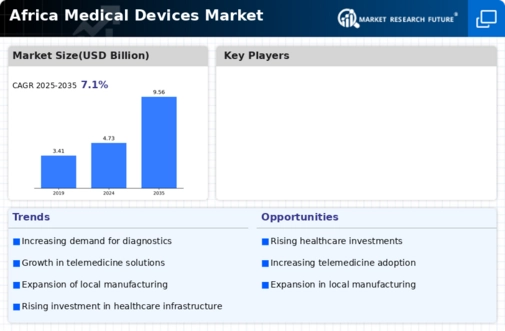Growing incidence of diseases is driving the market growth
One of the main factors fueling the growth of the Africa medical devices market CAGR is the rising prevalence of disorders. Acute and chronic illnesses, such as those affecting the heart, brain, joints, and respiratory system, are becoming more common. Ocular illnesses, hearing issues, and periodontal illnesses are becoming more common. The third-leading cause of visual impairment and the primary cause in the industrialized world is age-related macular degeneration (AMD). In addition, the aging population is expanding quickly due to the rising average life expectancy.
Chronic cardiac, neurological, and orthopedic illnesses are becoming more common as a result of risk factors such as diabetes, hypertension, tobacco use, and obesity.
Furthermore, cutting-edge technologies emerge as primary market trends for medical devices, driving market expansion. Recent medical technology and equipment advancements are anticipated to greatly improve the detection and treatment of many diseases. Regenerative medicine is gaining popularity due to its potential to use tissue engineering, therapeutic stem cells, and artificial organ creation to repair or replace damaged human cells, tissues, and organs. Due to numerous benefits like a 3D vision of the operating field, minimal risk of infections, and others, a growing number of end users are adopting surgical robots.
Compared to traditional and laparoscopic surgery, surgical robots provide several benefits. There are certain drawbacks to laparoscopic surgery, including the instruments' constrained range of motion and the surgeons' uncomfortable working positions. When a tissue biopsy is insufficient, impractical, or unavailable, liquid biopsy might be utilised as a backup or alternative. The process is currently crossroads between fundamental research and widespread clinical practice. However, their commercial applications are still in their infancy and are mostly restricted to enhancing treatment selection for late-stage tumors.
Additionally, medical device companies are repurposing existing manufacturing lines to produce medical goods like hand sanitizers, personal protective equipment (PPE), face masks, ventilators, etc., that are highly demanded to fight the coronavirus. For instance, AirCo, a manufacturer of alcoholic beverages, has moved the focus of its manufacturing facilities to produce hand sanitizers. Bev and Endless West, two new alcohol companies, are accelerating manufacturing. Similarly, a firm in Canada called INKSmith, which was producing creative and tech tools for children, is now producing face shields.
Manufacturers of personal protective equipment (PPE) like face shields and nasal swabs for COVID-19 testing include Massachusetts-based Markforged and Formlabs. Thus, driving the medical devices market revenue.
The ongoing advancements in technology and increasing healthcare demands are likely to drive the growth of the medical devices market across Africa, fostering innovation and accessibility in healthcare delivery.
World Health Organization (WHO)














Leave a Comment